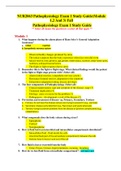Other
NUR2063 Pathophysiology Exam 1 Study Guide(Module 1,2 And 3)
- Course
- PATHOPHYSI NUR2063 SE
- Institution
- Rasmussen College
NUR2063 Pathophysiology Exam 1 Study Guide(Module 1,2 And 3)-1. What happens during the alarm phase of Hans Selye’s General Adaptation Syndrome? a. Initial reaction b. Sympathetic nervous system • Observed bodily changes produced by stress • The initial symptom that...
[Show more]



